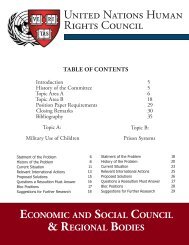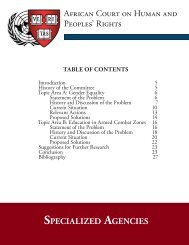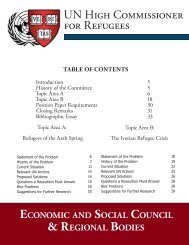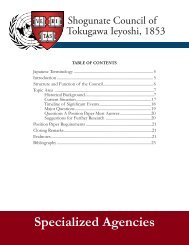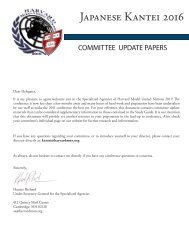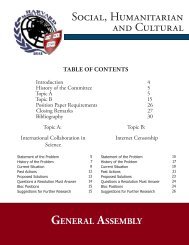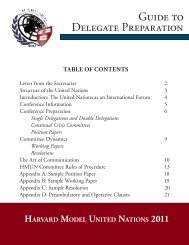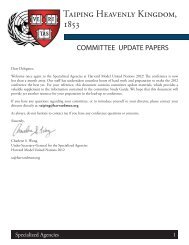World Trade Organization - Harvard Model United Nations
World Trade Organization - Harvard Model United Nations
World Trade Organization - Harvard Model United Nations
You also want an ePaper? Increase the reach of your titles
YUMPU automatically turns print PDFs into web optimized ePapers that Google loves.
<strong>World</strong> <strong>Trade</strong> <strong>Organization</strong><br />
trade promotes more long-distance transport, which is<br />
a major contributor to pollution and natural resource<br />
consumption; trade rules impede national governments’<br />
own environmental policies; the production of highly<br />
traded goods like cotton and cigarettes are more harmful<br />
to the environmental than the production of goods for<br />
domestic consumption which it replaces. 41<br />
The <strong>World</strong> <strong>Trade</strong> <strong>Organization</strong>’s challenge is<br />
to reconcile trade liberalization and environment<br />
protection. Since the WTO is, at the core, a trade-related<br />
organization, it must approach this reconciliation from<br />
the trade perspective. <strong>Trade</strong> rules are the most powerful<br />
tools that the WTO has. The WTO must reform current<br />
trade rules so that they can incorporate or consider<br />
MEAs and ensure that environmental considerations will<br />
become an essential part of all trade negotiations. The<br />
new set of international trade rules should reflect the<br />
mutual supportiveness that nations have been calling for<br />
during the past two decades.<br />
History of the Problem<br />
Environmental considerations were not the primary<br />
concerns when the international trade system was<br />
reformed after WWII. In the General Agreement on<br />
Tariffs and <strong>Trade</strong> (GATT) signed in 1947, the only<br />
mention of the environment was in the exception clause<br />
of Article XX, which allowed exceptions to normal trading<br />
rules if necessary to “protect human, animal or plant life<br />
or health, or to conserve exhaustible natural resources,<br />
provided that such measures do not discriminate between<br />
sources of imports or constitute a disguised restriction<br />
on international trade.” For the first decades of the<br />
GATT, no references were made to the environment in<br />
any dispute settlements, negotiations, and proceedings.<br />
The reason for the lack of presence in trade negotiations<br />
during the GATT’s formative decades is that trade was<br />
not perceived to be an environmental issue. There was<br />
not enough economic evidence that suggested that trade<br />
had a direct impact on the environment. 42<br />
After decades of silence, environmental issues<br />
regarding trade finally came up on the GATT agenda<br />
in the 1980s. Developing countries were concerned<br />
about the trading of goods that had begun to be banned<br />
in wealthier, exporting countries. Meanwhile, other<br />
discussions regarding trade’s impact on the environment<br />
were appearing in various conventions throughout the<br />
world. Some conventions were successful in ratifying the<br />
first international agreements limiting the impact of trade<br />
on the environment. These include the Basel Convention<br />
on the Control of Transboundary Movements of<br />
Hazardous Wastes and their Disposal and the Convention<br />
on Prior Informed Consent for Hazardous Chemicals<br />
and Pesticides in International <strong>Trade</strong>. 43<br />
Environmental issues regarding trade exploded in the<br />
1990s. They began with a series of heated environmentalrelated<br />
trade disputes in the early 1990s, most notably the<br />
tuna-dolphin dispute between Mexico and the <strong>United</strong><br />
States. The US imposed an import ban on tuna harvested<br />
in the Eastern Tropical Pacific Ocean because the process<br />
of catching the tunas in that area involved the killing<br />
of numerous dolphins. When Mexico complained to<br />
the governing body of the GATT, an adjudication panel<br />
convened. Shockingly, the panel ruled in favor of Mexico,<br />
stating that the US violated core GATT principles<br />
including a provision that prohibited discrimination of<br />
imported produces on the basis of process and production<br />
methods. The environmental community viewed this<br />
ruling as a threat to the environmental movement and<br />
the legal status of trade-related provisions in multilateral<br />
environment agreements (MEAs). On the other hand,<br />
the trade community welcomed this ruling since it<br />
feared that allowing trade barriers for extra-territorial<br />
environmental objects would open the door to further<br />
trade-restricting measures that would hide under the<br />
mask of environmental protection. 44<br />
There was much anti-trade sentiment after the<br />
GATT ruling on the tuna-dolphin dispute. In order to<br />
restore public trust in the international trading system,<br />
the European Free <strong>Trade</strong> Association requested the<br />
reconvention of the dormant Group on Environmental<br />
Measures and International <strong>Trade</strong> (EMIT). After two<br />
years of research and work, the Group reported to<br />
the 49 th Session of the Contracting Parties in January<br />
1994. The report supported a trading system that could<br />
reconcile the conflicts between environmental protection<br />
and trade and formed the basis for the Decisions on<br />
<strong>Trade</strong> and Environment, a ministerial declaration at the<br />
Uruguay Round Marrakesh Ministerial meeting in April<br />
1994. The Decision called for the creation of a Committee<br />
on <strong>Trade</strong> and the Environment, which would work to<br />
reconcile environment-related trade disputes. 45<br />
The creation of the WTO in 1995 from the<br />
Marrakesh Agreement ensured that environmental issues<br />
would be considered alongside trade policies in the<br />
international multilateral trading system. The objectives<br />
of the WTO now include embracing the principle of<br />
sustainable development, which, as defined by the <strong>World</strong><br />
14<br />
Specialized General Assembly Agencies





